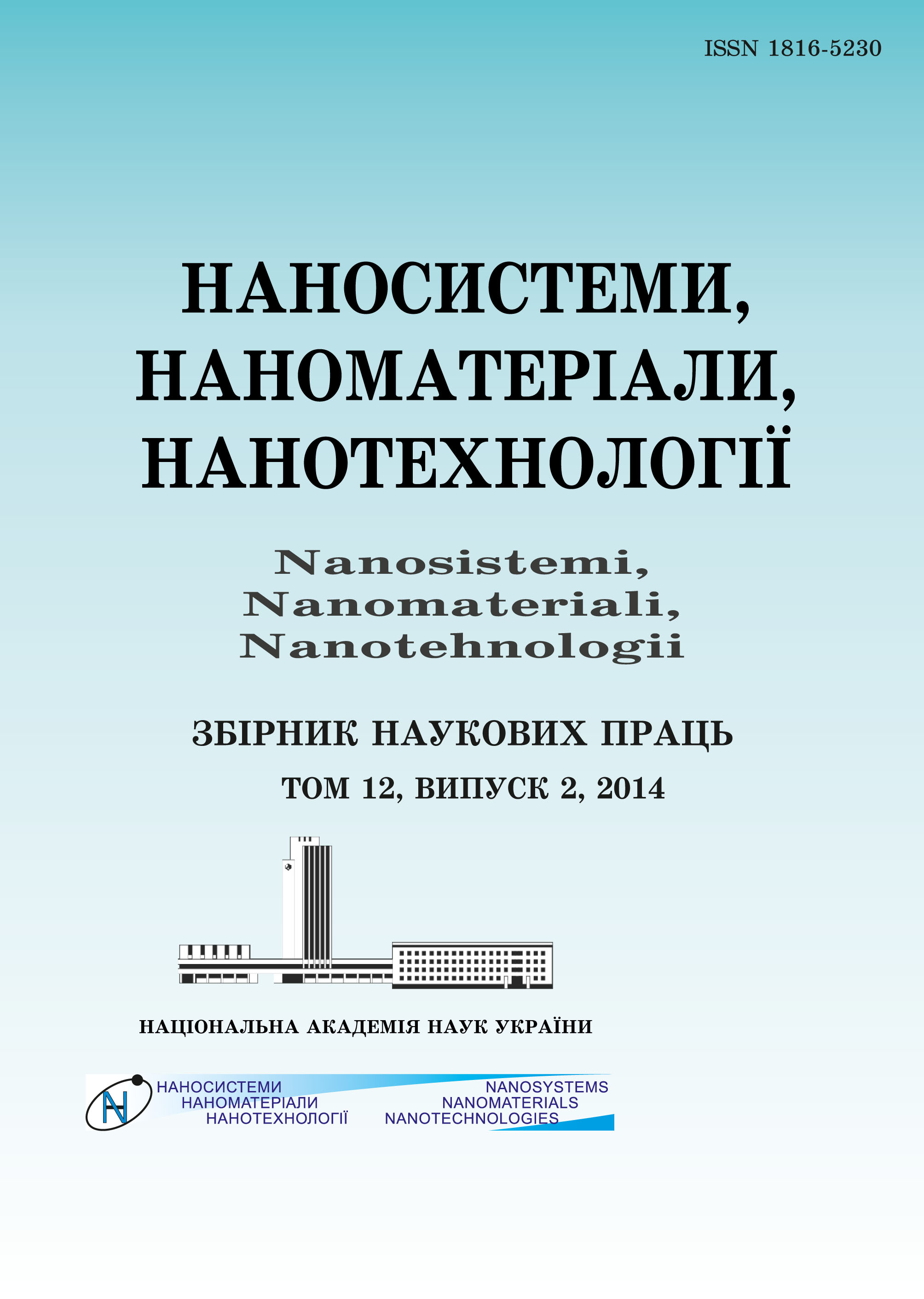|
|
|||||||||
 |
Year 2023 Volume 21, Issue 2 |
|
|||||||
|
|||||||||
Issues/2023/vol. 21 /Issue 2 |
B. B. Kolupaev, B. S. Kolupaev, V. V. Levchuk, Yu. R. Maksymtsev, and O. V. Matviichuk
Mathematical Modelling of the Process of Thermodestruction of Polyvinyl Chloride Filled with Nanodisperse Metals
0331–0347 (2023)
PACS numbers: 61.41.+e, 64.75.Va, 81.05.Lg, 81.07.Pr, 82.35.Lr, 82.35.Np, 83.80.Tc
The effect of nanodispersed metal filler (copper (Cu), graphite (C)) obtained by means of the electrical explosion of conductor (EEC) and electrolysis in the amount (φ) 0 ≤ φ ≤ 0.10 vol.% on the value of thermal destruction of polyvinyl chloride (PVC) systems in the temperature range 298 K ≤ T ≤ 660 K. The calculation of the change in the mass of PVC systems under the influence of the temperature field is carried out that make it possible to propose an optical microscopy method, which can be used in the central factory laboratories (CFL) as a basis for the study of thermal destruction of the composite. As shown with using it, under the action of the active surface of nanodispersed Cu and C, non-linear changes in the kinetic parameters of thermodestruction occur, which are confirmed by the intensive growth of the optical density of the 1428 cm-1 band. The maximum effect of heat resistance of PVC systems is observed if 0.04 ≤ φ ≤ 0.08 vol.% Cu due to the donor–acceptor interaction between Cu ions (acceptor) and polar Cl groups, providing ΔÅ = 8.0·10-20 J. The anharmonicity factor of the Cl atom in relation to the main valence circle is of 0.9 (initial PVC), 3.6·10-2 (at φ = 0.01 vol.% Cu) and 1.7·10-7 (at φ = 0.10 vol.% Cu). As shown, the changes in the values of structural–kinetic activity, packing coefficient, free energy, internal pressure, activation energy of thermal destruction are caused by PVC structure formations, which have different lifetimes. The relaxation mechanism of the thermodestruction process of PVC + copper–graphite systems is established, where the ‘arrow’ of action is the energy of the external field ensuring the fulfilment of the principle of temperature–time equivalence. Nanodispersed Cu and C powders can be recommended as active PVC fillers. Their presence ensures thermal oscillations of the H, Cl, C atoms at Ò ≥ 410 K (with a packing coefficient K = 0.64 in a volume of 3.8·10-19 m3 around the quasi-equilibrium position) intensively causing a change in the value of the boundary layer in the range of 2.5·10-18 m3 ≤ Vbl ≤ 1.2·10-7 m3. The results of the calculations serve as the basis for forecasting, fabrication and operation of PVC systems with an adjustable set of properties.
Key words: thermodestruction, flexibility of macromolecules, nanodispersity, structural element, relaxation.
https://doi.org/10.15407/nnn.21.02.331
References
- Yu. S. Lipatov, Kolloidnaya Khimiya Polimerov [Colloid Chemistry of Polymers] (Kiev: Naukova Dumka: 1967) (in Russian).
- S. Ja. Frenkel’, I. M. Tsygel’nyy, and B. S. Kolupaev, Molekulyarnaya Kibernetika [Molecular Cybernetics] (L’viv: Svit: 1990) (in Russian).
- I. N. Andrusimina, Ukrainskyi Zhurnal Suchasnykh Problem Toksykolohii, 3: 5 (2011); http://protox.medved.kiev.ua/index.php/ru/issues/2011/3/item/93-metal-nanoparticles-types-of-production-physicochemical-properties-methods-of-investigation-and-toxicity-assessment
- D. R. Paul and L. M. Robeson, Polymer, 49, No. 15: 3187 (2008); doi:10.1016/j.polymer.04.017
- B. S. Kolupaev, Relaksatsionnyye i Termicheskie Svoistva Napolnennykh Polimerov [Relaxation and Thermal Properties of Filled Polymers] (L’viv: Vyshcha Shkola: 1980) (in Russian).
- T. Yoshikatsu, Polym. Degrad. Stab., 96, No. 7: 1321 (2011); doi:10.1016/j.polymdegradstab.2011.03.019
- P. H. C. Camargo, Mat. Rec., 12, No. 1: (2009); http://dx.doi.org/10.1590/S1516-14392009000100002
- B. B. Kolupaev, Surf. Engin. Appl. Electrochem., 44: 133 (2008); https://doi.org/10.3103/S1068375508020105
- A. A. Askadskiy and V. I. Kondratenko, Kompyuternoye Materialovedenie Polimerov. Atomno-Molekulyarnyi Uroven [Computer Materials Science of Polymers. Atomic-Molecular Level] (Moskva: Nauchnyi Mir: 1999), vol. 1 (in Russian).
- B. B. Kolupaev, V. V. Klepko, E. V. Lebedev, and T. G. Lyashuk, Polym. Sci. Ser. A, 56: 337: (2014); https://doi.org/10.1134/S0965545X14030067
- D. S. Sanditov and G. M. Bartenev, Fizicheskie Svoistva Neuporyadochennykh Struktur [Physical Properties of Disordered Structures] (Novosibirsk: Nauka: 1982).
- M. Kardar, Statistical Physics of Particles (Cambridge: Cambridge University Press: 2007); https://doi.org/10.1017/CBO9780511815898
- V. F. Kuropatenko, Doklady RAN, 403, No. 6: 761 (2005) (in Russian).
- B. B. Kolupaev, B. S. Kolupaev, V. V. Levchuk, Yu. R. Maksimtsev, and V. O. Sidletskiy, Zh. Nano- Elektron. Fiz., 10, No. 2: 020025(5) (2018); http://essuir.sumdu.edu.ua/handle/123456789/68501
- B. B. Kolupaev, B. S. Kolupaev, V. V. Levchuk, B. D. Nechyporuk, Yu. R. Maksimtsev, and V. A. Sidletskii, Mech. Compos. Mater., 54: 333 (2018); https://doi.org/10.1007/s11029-018-9743-7
- Novoye v Metodakh Issledovaniya Polimerov [New in Polymer Research Methods] (Eds. Z. A. Rogovina and V. P. Zubova) (Moskva: Mir: 1968) (in Russian)
 This article is licensed under the Creative Commons Attribution-NoDerivatives 4.0 International License ©2003—2023 NANOSISTEMI, NANOMATERIALI, NANOTEHNOLOGII G. V. Kurdyumov Institute for Metal Physics of the National Academy of Sciences of Ukraine. E-mail: tatar@imp.kiev.ua Phones and address of the editorial office About the collection User agreement |